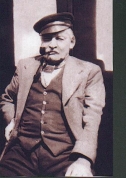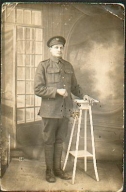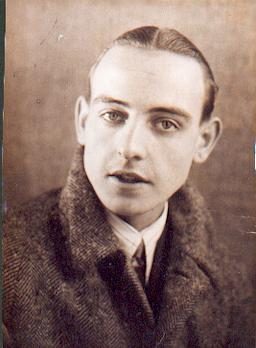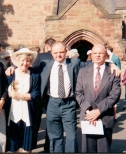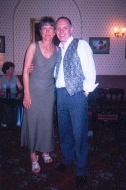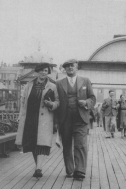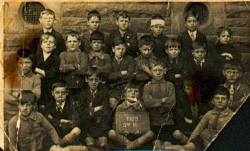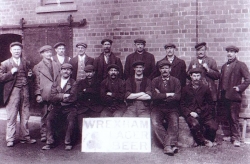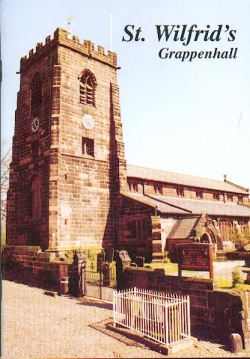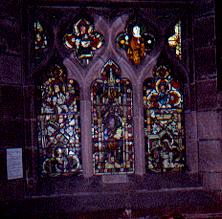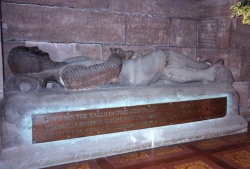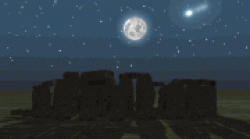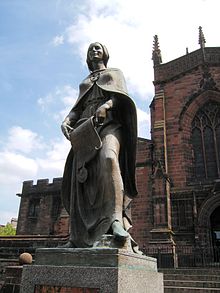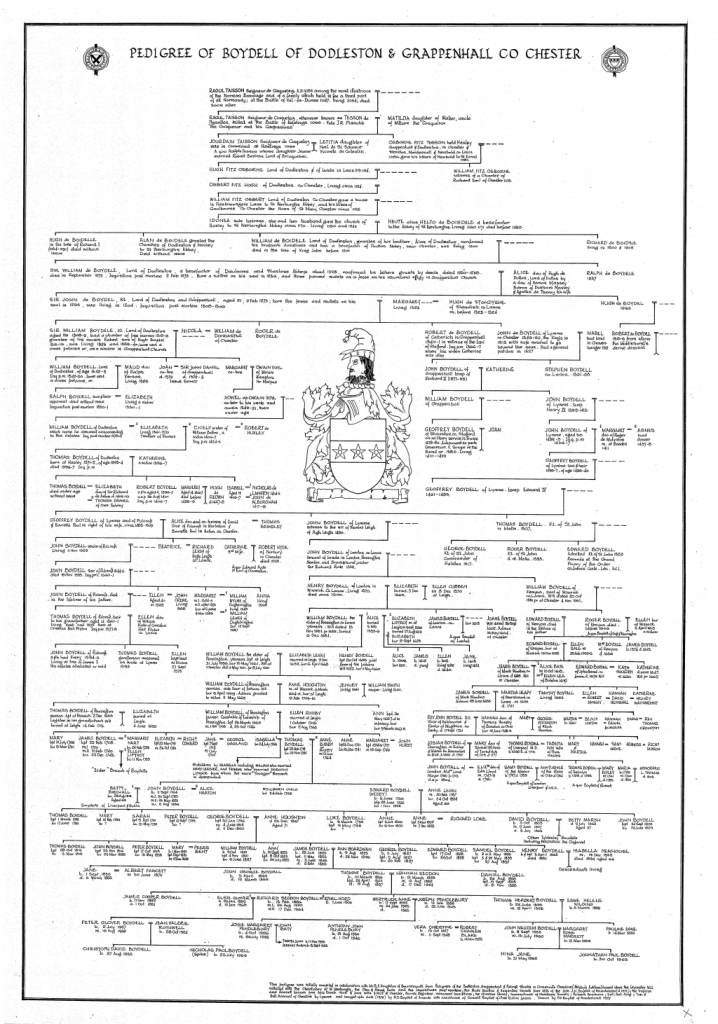GRAPPENHALL AND ITS ANTIQUITIES
A lecture by Arthur Mounfield, F. R. Hist. S.
From "The Warrington Examiner" of June 2nd and 9th 1923
The first mention of Grappenhall (or Gropenhale, to use the ancient name) is in the Doomesday book. This famous survey of England was made by order of William of Normandy after the Conquest.
His comissioners were instructed to put on record the names of those who held the land in the days of Edwarad the Corfessor, the extent and nature of the aress, how many mills and fishponds, how much the land was worth in Edward's time, and how much after the upheaval of the Conquest.
This is how Grapenhall is reporteed upon:
Osbern (Fitz Tezzon) holds Gropenhale and Edward of him, he and Dot, both freeemen, held it as two manors. There is one hide and half a virgat of Land ratable to the gelt. The land is two carucates, one and a half of which are demesne; and there are two serfs and one villein and three bordars. There is a wood one League long and forty perches broad. There are two hays. Its value in King Edward's time was five shillings (a year); it is now worth six shillings. When it came to the Earl of Chester it was waste.
The information is slight, but it is interesting. It means that the areas we call Latchford, Latchford Without and Grappenhall were held in Saxon days by two men named Edward and Dot. The county of Cheshire was devastated by fire and sword, and when it came to Hugh Lupus, who received the county as his portion, it was next to worthless. "It was waste," says the record; and under those pitiful words lie naterials for one of the most tragic volumes that could be written, a story of brave and simple men destroyed, their houses and crops burned and plundered. England changed hands amid pillage and blood, and the smoke of ruin filled the landscape.
The change that took place at Grappenhall was typical. Edward and Dot, the two Saxons, were put in charge under the new order. To cultivate the 2400 acres they had two serfs, one villein, and three bordars.b Allowing that all may have had families, the population of Latchford and Grappenhall would scarcely reach fifty. In the wood three miles long they would hunt the deer, the freemen taking the venison, the serfs and bordars eating the umbles or remnants in the form of "umble pie." Beyond a guess that they lived the simple life, and a confident statement that Latchford Without was not famous for villa architecture, we cannot say much about the home life of Edward and Dot. It is possible to picture Grappenhall with the pigs that feed upon the acorns in its forest and the serfs and villein who tend them, but of Edward and Dot we hear no more. They come and go in that ore sentence in the Domesday Book.
We must take notice of the new owner to whom the Conqueror gave the land, because he was the ancestor of the Boydells and the Middlehursts, and his children's names fill many a misty charter. It should be explained that Hugh Lupus, who became Earl of Chester, received the county of Chester from William the Conqueror, and he in turn divided it among his followers, of whom Osbern was one.
Osbern Fitz Tezzon, the Norman, was a man of some note. Posssibly he saw little of Grappenhall and Latchford, for he held also Lyme ,Warburton, Appleton, Hanley, Gresford and some other places. What in more important, he held, under Hugh Lupus, the castle of Dodleston, a very exacting post on the Welsh border. Osbern left Grappenhall to his son Hugh Fitz Osbern, who in turn had a son named Osbern Fitz Hugh.
This Osbern the third had a son named Helto, who called himself Helto de Boydell. Thus came in the name of Boydell, which was destined to be associated with the village for centuries. Helto's son was named Hugh de Boydell, and I bring him into my lecture because it is in ine of his documents that the name Latchford first appears. Here it is:
"Randle, Earl of Hhester, sendeth greeting, etc. Be it known to you that I have granted to Hugh De Boydell, the way in Latchford, with the passage of the water of Mersey, between Runcorn and Thel Wall, and that no wain of the two horses shall pass the saidd way and passage except by the allowance of the said Hugh and his heirs."
Which probably means in plain terms Hugh de Boydell was given the right to levy a toll upon those using the fords of the river.
The date of this falls in the early part of the reign of Richard I, possitly about A.D. 1190. So long has Latchford had its name.
In l250, as an act of homage to the Church, William de Boydell by a charter gave "acquittance" to the Abbot and monks. be confirmed to God and the Blessed Mary that "the said Abbot and Monks for ever shall pass through my vill Of Latchford with all things belonging to them without anything being required for the said passag. And for this grant and quit-claim neither I nor my heirs shall ask anything except their prayers and supplications."
In a later charter dated 1308 Sir John Boydell gave to the hermit friars of Warrington, the members of the religious house at Bridge Foot,
A free passage through the vill of Latchford for their wains, by what name soever they may be called, so that every priest brother of the convent celebrate mass on the day of my anniversary." This is done, he says, "for the health of my body and the safety of my soul."
These charters give us the only glyimpses we have of Grappenhall when it was a preserve of its feudal lord. The exchanging of privileges for prayers and masses by written agreement was quite characteristic ofthe period. Sir John allows the monks to pass along his roads and through his "vill of Latchford" without paying the toll which is exacted from everybody else; but they most covenant in solemn charter to celebrate an annual mass for him on his anniversatry day.
Other writings of the ancient Boydells have come down to us and they contain many things that arrest and half-amuse the modern reader. There are, for instance, grave charters written in Latin which allow the landholders' pigs, for a consideration, to eat the acorns which fall from my lord's Oaks.
Such a document, dated 1270, is in the name of William Boydell whose effigy reposes in the church, and this William, it may be noted, advanced the fortunes of his house by marrying Alice, a daughter of Hugh de Dutton. The Visitor may see that spot where the Boydells lived. On the high ground at Reddish hall they were "monarchs of all they surveyed." The old house has gone, but the moat which surrounded it remains. Now a few words about the church. We do not know by whose fostering a church first arose at Grappenhall.
It is hardly likely that there was a place of prayer here at the time of the Conquest. The Doomesday Book, with its mention of a church at Lyrmn, suggests that Lyrnin would be the religious centre of the Osbern territory.
But there is little doubt that a church was built at the beginning of the 12th century, and of this structure one interesting portion retains. The foundations, which were uncovered fifty years ago, show it to have been a small building. It would have roundheaded ~Norman windows and possibly a porch. Happily for our interest, a scrap of the old buildig is left. When rebuilding took place in the 16th century, instead of demolishing the south wall, as they did the north, it was pierced and arches placed within it.
The upper portion was therefore left, and with it the corbel table and gargoyles of the Norman Church. These quaint faces carved by the early builders have looked down on the worshipper for about eight centurie. Formerly upon the outer wall of the church, they are now sheltered by the roof of the south aisie and are seen from within. Another relic of the first church is the Norman font.
This was rescued from oblivion fifty years ago. Rejected in favour of a new one in the 16th century, it was found buried beneath the church floor. Many fine old fonts came to grief at the hands of restorers during sleepy periods of our history, and they are constantly being rescued from base uses. Many of them have served as pig troughs. It is gratifying that in Tudor England there were minds sufficiently astute to perneive that a good large font would make an admirable feeding trough. Antiquarians are grateful, because events nave proved that the fonts were safer with the pigs than with the humans. Many fine Saxon and Norman fonts have been been restored to their original use after being for centuries in the safe custody of the pigs; this one, after serving as font for four and a half centuries, was buried under ground as being ugly and out of date. Placed upon its new pedestal it is now one of the treasares of the church. In measurement it is two feet seven inches long, two feet wide, and one and a half feet deep. It is of local red stone and decorated with Norman arches of rather rude workirianship. There are one or two traces of history upon it which are too interesting to miss. In 1236 the Archbishop of Canterbury required that all fonts shuld be covered and locked. At a later time, possibly at the Reforrration, the cover has been removed.
The marks of the staples and the injury done in wrenching it away can be seen in the stone, though the broken portions ave been restored. Another relic of the Ncnnan Church rests in the Warrington museum. This is the parish chest, and it is about as crude as a chest can well be. It consists of a portion of the trunk of a tree about seven feet long, a slab forming the lid. A cavity cut in the tree about two feet long would hold, perhaps, the altar vessels, but little more. It is a hollow log chopped srnooth by an axe, and as a piece of church furniture, is almost unique.
To the Norman Church at Grappenhall, a very interesting addition was made in the year 1334. This was the Boydell Chapel, built on the south side, and of which some valuable portions remain.
To discover the origin of the chapel we go back again into the realm of charters, to find William Boydell arranging for a chaplain to celebrate mass for ever for the repose of his soul. The document is too interesting to be omitted:-
Be it known to all men that I, William Boydell the younger, have covenanted to find one honest chaplain to celebrate devind mysteries for ever for the soul of William Boylell, my father, the soul of Nicola, my mother, the souls of the faithful dead in the chapel of Gropenhall, built by the said lord William, my father.
And for the better security of this matter, I William Boydell, Junior, have sworn on the holy cross, in the collegiate church of St. John in Chester, in the presence of the aforesaid William, my father, William of Mulneton, Robert de Hawardyn, and Henry, given at Chester, 19 January, 1334.
It is clear from this document that the chapel was built by William Boydell the elder and endowed by William the younger.
The building was placed against the south wall, and would have a separate entrance. When the building was enlarged in the sixteenth century the chapel was merged in the aisle.
Sixty years ago the aisle was extended eastwards, and by the process the east wall of the chapel was removed.
It is for us, tflerefore to see how much is left of the ancient Boydell Chapel after this severe mutilation.
Though the relics are few, every antiquary would agree that they are vary valuable. First, there is the window, which is the second from the east end of the aisle. This is a good and characteristic piece of fourteenth century archtecture.
Very happily, too, we have some of the ancient glass. The most beautiful is that which represents, under canopies, the Apostle Peter with keys; James, represented as a pilgrim with a palmer's staff and escalioped hat; Barnabas, with a flaying knife and his skin in his hand, in token that he had been flayed; and Thomas and Philip. Mary Magdalene, with her ointment, and John the Baptist also fill large places in this interesting window.
It was usual to represent the Apostle James as a pilgram, form the fact that pilgrims bore a palm branch they were called palmers, and they are usually shown with a scallop shell upon the
hat. Both the palmer's staff and a hat adorned with a shell appear in this picture of James. But the best example of the glass with which the mediaeval builders adorned their churches is preserved in the door of the organ screen. The figure is that of a female saint, shown with clasped hands, ermine dress, and a halo. There is no emblem to give identity. The colours are golden yellow and brown. This relic, the chaste workmanship of seven centuries ago, gives us much room for thought and admiration.
It is said that before the Reformation, Grappenhall was famous for its glass, but these are the only fragments that are left. Other pre-Reformation relics have a modest place under the shadow of the organ, and are often missed by the visitor.
Built into the wall are a piscina and credence table.
Of course, this is not their true place. They would origirally occupy a position near to the altar, or were possibly in the Boydell Chapel. The piscina was a sacred lavatory of the church.
In it the priest washed the altar vessels and washed his hands after the observance of the mass. It was pierced to allow the water to drain through the wall of the church, The credence was a small projecting table which held the emblems. The old church would have also before the Reformation a stoup for holy water, but this has not survived. We must now study a famous relic which once rested in the Boydell Chapel, and after a sojourn in the Warrington Museum, and a process of restoration, lies within the altar rails. The effigy is that of William Fitzwilliazn Boydell, Crusader and lord of Grappenhall six and a half centuries ago.
He is represented as a warrior who rests after his battles. He is in chain armour and his head rests upon a helm. This was the William Boydell, who married Alice of Dutton and who died in 1272. It was long the popular belief that the crossed legs of these mediaeval effigies indicated the Crusader. The heroes who had been once to Palestine to fight the Saracens were said to be represented with legs crossed at the ankles. Those who had been twice were shown with legs crossed below the knees, and those who had been three expeditions were shown crossed above the knees.
Some antiquarians regard the leg-crossing as a mere fashion in effigies, but most people have preferred to believe that a straining of the human figure so drastic as this must have had some meaning. It does seem as though the Boydells had something to do with the Holy Wars, for they placed a Turk's Head upon their creste.
It survives in the familiar "Saracen's head" at Wilderspool, which is an interesting reminder of the days when the noble went out to try to deliver Palestine out of the hands of the Turk.
I am forgetting to mention that the church is dedicated to St. Wilfred. This northern saint would be in the minds of the ecclesiastics of the twelvth century by reason of a discussion as to the custody of his remains. It is said that in A.D. 958 Archbishop Odo discovered his bones in a neglected condition at Ripon and carried them to Canterbury, leaving as many bones as would work sufficient miracles for the Northerners. Modern Christians don't give themselves anxiety about the bones of the saints, but at that period the possession of relics was a matter of imortance, and the fact that Wilfred's fragments went to Canterbury argued for the superiority of that city over York.
The dedication of a church usually affected its orientation.
Perhaps I had better put this in simpler terms. Churches were always built with the altar to the east, but they were not placed due east and west as by a compass. The centre line of the church was often arranged so as to point to that spot on the horizon on which the sun rose on the festival of the patron saint.
Such has been the usual belief, but it is only right to say that the subject of variations in orientation presents many difficulties, and some good antiquarians have given up hopes of a solution. The orientation of Grappenhall fits a day in April and August. It may, therefore, have been intended to suit St. Wilfred's birthday in August or the removal of his bones to Canterbury, which took place in April.
The Nornan Church which I have described remained until the beginning of the sixteenth century. Then came an alirost entire rebuilding. The date A.D.1539 carved upon one of the pillars, is supposed to record the coirpletion of this large task.
The builder placed the north pillars upon the foundation of the old wall and built out a north aisle. The south wall was treated in the way I have described, the pillars and arches being inserted in it, and the top portion with its gargoyles and obrbel table left. The massive tower rose at the west end, as we see it now, save that it once had eight pinnacles. On the string course which encircles it is carved the figure of a large cat. Possibly, it is a coat of arms, and it has been suggested that it represents a pun on the name Caterich, a familiar name and property in the parish. Since 1539 various changes have occurred. The Boydell Chapel, as we have seen, lost its identity by the lengthening of the east aisle. The walls of the nave were raised and clerestory windows inserted, and a large vestry built. In this vestry is placed the old east window Of the church.
The tower has six bells, five of which are dated 1700 and one 1718. These are the inscriptions:
R.S. tho sutton tho merry C.W. 1718. John Boardman, rector, 1700. Henricus Bagley, nosfecit 1700.
Henricus Bagley, of Ecton, neare Northampton, made nee, 1700
Thomas Blackburne and Thomas Sutton, Churchwardenens, 1700
I to the Church the living call, and to the grave doe summon all.
Other features might profitably detain us if there were time.
The Stocks are a well preserved relic, and there is a fine sundial dated 1747 with its motto "Pulvis et umbra sumus."
But These antiquities are mere striplings in comparison to the yew tree under whose shade they stand. There would be mateial for quite a small lecture in this rugged yet kindly giant were
there but time to give it. The age of many churchyard yews is beyond all calculation. Wordsworth reminds us that these trees furnished -
"....Weapons for hands
That drew their sounding bows at Agincourt,
Perhaps at earlier Crecy or Poictiers."
This is no poetic exaggeration, for the life of an ordinary yew is 400 years, and one still lives at Darley Dale Which experts declare to have weathered a millennium. It is possible that the Grappenhall yew may have given shelter to the William Boydell who rode away in chain armour to fight the Saracens in the far-off days of the thirteenth century. Collectors of epitaphs may increase their stock from the churchyard, but this is another of the smaller interests which I must leave untouched.
Seeing Grappenhall, as we do, upon a fair spring day, you will agree that it is a spot to linger in and a place to be loved.
Providence has surely kept it as a restorative for jaded nerves; a place where Gray might have written his Elegy; or Wordsworth his "Yew Trees." May quietness prevail; may its sleeping warrior long rest undisturbed by the hooting of motor horns and undistressed by the smell of petrol.
And may its "yew tree's shade" and pleasing antiquities be long preserved to soothe and delight other generations as they have refreshed us.
